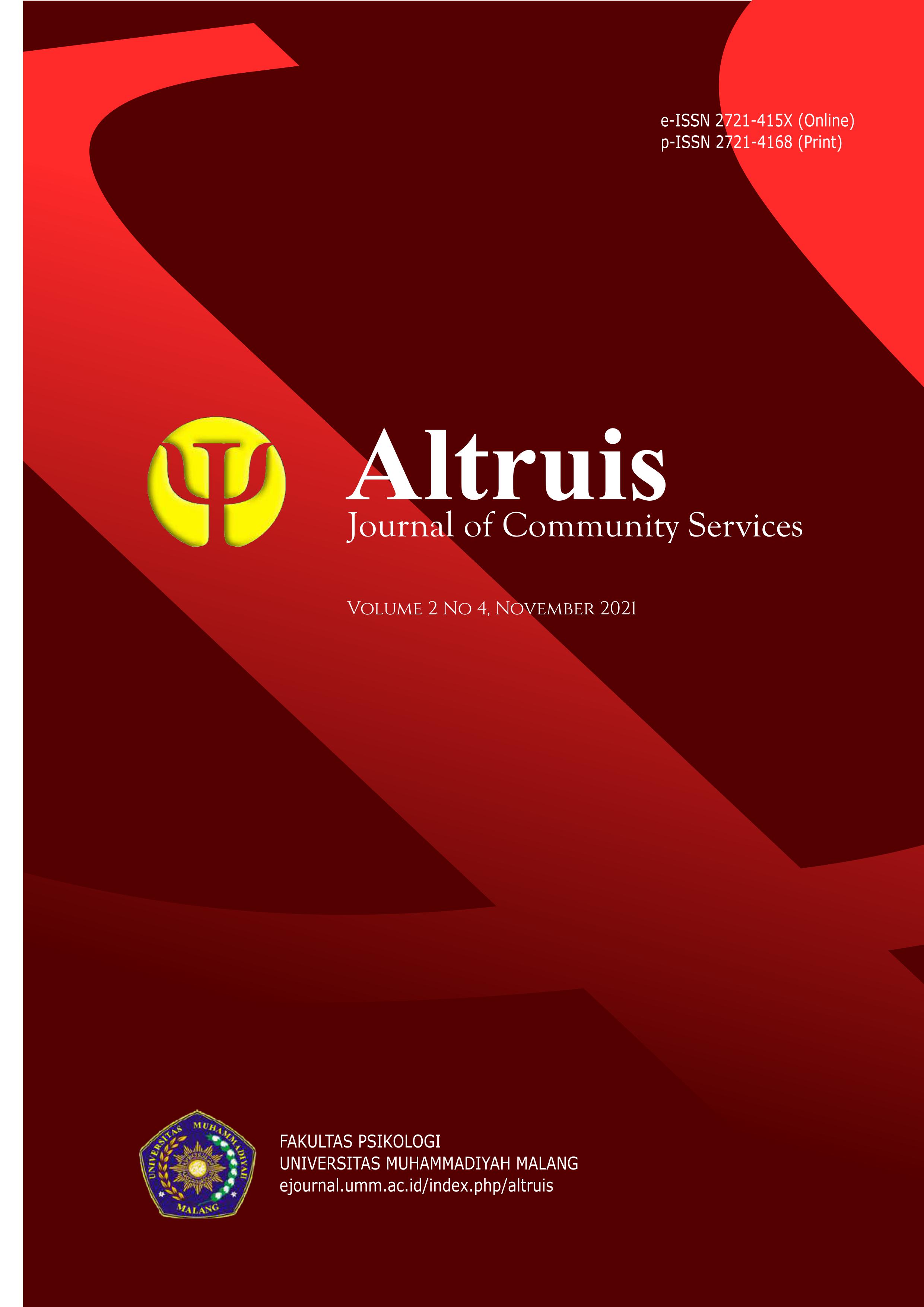Pengembangan Pola Berpikir Sistematis Melalui Pengenalan Pemrograman Visual Pada Peserta didik Tingkat Menengah Atas
DOI:
https://doi.org/10.22219/altruis.v2i4.18427Keywords:
computational thinking, pemrograman visual, pola berpikir sistematis, ScratchAbstract
Systematic thinking is a process of thinking that should be introduced from early age. While developing such thinking, students will learn how to solve a task by breaking it down to smaller tasks and complete them one by one. There are many activities that can support such thinking. One of them is to program visually. Visual programming is usually featured with drop-down blocks where students are only required to choose which process or logic needed than then put them in the play board. A training of such activity was done in a high school at Bandung, Indonesia with Scratch. Students were first introduced with Scratch, a software that is expected to help them think systematically. For conducting the training itself, several stages were followed. It started with introduction, and then followed by lecture and case-based practice. To engage students with the practice, the case study is COVID-19 where students are expected to deliver relevant information creatively, such as developing a game of social distancing, spray vs virus, etc. Evaluation shows that via this training, students were able to further develop their own systematic thinking via the creation of Scratch projects. Further, they believed that this training is interesting and can help them to study in the high school.
Downloads
References
Ayub, M., Wijanto, M. C., Senjaya, W. F., Karnalim, O., Kandaga, T., Witono, T., . . . Gantini, T. (2017). Edukasi Berpikir Komputasional melalui Pelatihan Guru dan Tantangan Bebreas untuk Siswa di Bandung pada Tahun 2016. Seminar Nasional Pengabdian Kepada Masyarat (Sendimas). Bandung.
Bebras Indonesia. (2021, Oktober 5). Apa Itu Bebras. Diambil kembali dari Situs Resmi Bebras Indonesia: https://bebras.or.id/v3/apa-itu-bebras/
Cooper, S., Dann, W., & Pausch, R. (2000). Alice: A 3-D Tool for Introcutory Programming Concepts. Journal of Computing Sciences in Colleges, 15(5), 107-116. doi:10.5555/364133.364161
Dagiene, V., & Stupuriene, G. (2016). Informatics Concepts and Computational Thinking in K-12 Education: A Lithuanian Persepective. Journal of Information Processing, 732-739. doi:10.2197/ipsjjip.24.732
Dasgupta, S., & Hill, B. M. (2017). Learning to Code in Localized Programming Language. L@S '17: Proceeding of the Fourth (2017) ACM Conference on Learning @Scale (hal. 33-39). New York: Association for Computing Machinery. doi:10.1145/3051457.3051464
Guo, P. J. (2013). Online Python Tutor: Embeddable Web-Based Program Visualization for CS Education. Proceeding of the 44th ACM Technical Symposium on Computer Science Education. New York: ACM Press. doi:10.1145/2445196.2445368
Idrees, M., Aslam, F., Shahzad, K., & Sarwar, S. M. (2018). Towards a Universal Framework for Visual Programming Languages. Pakistan Journal of Engineering and Applied Science, 55-65.
Iskandar, W., Azkia, N., & Hasanah, H. (2019). Konsep Pembelajaran Tematik. Yogyakarta: K-Media.
Karnalim, O., & Wijanto, M. C. (2021). Transitioning to Online Learning for Indonesian High School Students: Challenges and Possible Solutions. 2021 International Conference on Advanced Learning Technologies (ICALT), (hal. 428-430). doi:10.1109/ICALT52272.2921.99136
Kölling, M. (2010). The Greenfoot Programming Environment. ACM Transactions on Computing Educations, 10(4), 14:1-14:21. doi:10.1145/1868358.1868361
Moreno, A., Myller, N., Sutinen, E., & Ben-Ari, M. (2004). Visualizing Programs with Jeliot 3. Proceedings of the Working Conference on Advanced Visual Interfaces, (hal. 373-376). New York. doi:10.1145/989863.989928
Muharika, D., & Fitria, R. A. (2019). Kebutuhan Pengembangan Modul Bimbingan Teknologi Informasi dan Komunikasi (TIK) Terintegrasi Literasi Baru Era Revolusi Industri 4.0. Jurnal PTI (Pendidikan Teknologi Informasi), 6(1), 80-86. doi:10.35134/jpti
Nathasya, R. A., Karnalim, O., & Ayub, M. (2019). Integrating Program and Algorithm Visualisation for Learning Data Structure Implementation. Egyptian Informatics Journal, 193-204. doi:10.1016/j.eij.2019.05.001
Resnick, M., Maloney, J., Monroy-Hernándes, A., Rusk, N., Eastmond, E., Brennan, K., . . . Kafai, Y. (2009). Scratch: Programming for All. Communcations of the ACM, 52(11), 60-67. doi:10.1145/1592761.1592779
Scratch Team. (2021, 09 22). About Scratch. Diambil kembali dari https://scratch.mit.edu/about
Wijanto, M. C., Karnalim, O., Ayub, M., Toba, H., & Tan, R. (2021). Transitioning from Offline to Online Learning: Issue from Computer Student Perspective. IEEE Global Engineering Education Conference (EDUCON). Vienna. Diambil kembali dari https://doi.org/10.1109/EDUCON46332.2021.9453996
Wijanto, M. C., Tan, R., Sujadi, S. F., Panca, B. S., Toba, H., Yulianti, D. T., . . . Karnalim, O. (2021). Implementasi Computational Thinking Melalui Pemrograman Visual dengan Kolaborasi Mata Pelajaran pada Siswa Menengah Atas. Sendimas.
Zhang, L., & Nouri, J. (2019). A Systematic Review of Learning Computational Thinking Through Scratch in K-9. Computers & Educations, 141. Diambil kembali dari https://doi.org/10.1016/j.compedu.2019.103607
Downloads
Published
How to Cite
Issue
Section
License
Copyright (c) 2021 Robby Tan, Maresha Caroline Wijanto, Oscar Karnalim, Setia Budi, Mewati Ayub, Diana Trivena Yulianti, Hendra Bunyamin, Sendy Ferdian Sujadi, Rossevine Artha Natasya

This work is licensed under a Creative Commons Attribution-ShareAlike 4.0 International License.
Authors who publish in Altruis agree to the following terms:
- For all articles published in Altruis, copyright is retained by the authors. Authors give permission to the publisher to announce the work with conditions. When the manuscript is accepted for publication, the authors agree to automatic transfer of the publishing right to the publisher.
- Authors retain copyright and grant the journal right of first publication with the work simultaneously licensed under a Creative Commons Attribution-ShareAlike 4.0 International License that allows others to share the work with an acknowledgment of the work's authorship and initial publication in this journal.
- Authors are able to enter into separate, additional contractual arrangements for the non-exclusive distribution of the journal's published version of the work (e.g., post it to an institutional repository or publish it in a book), with an acknowledgment of its initial publication in this journal.
- Authors are permitted and encouraged to post their work online (e.g., in institutional repositories or on their website) prior to and during the submission process, as it can lead to productive exchanges, as well as earlier and greater citation of published work (See The Effect of Open Access).
This work is licensed under a Creative Commons Attribution-ShareAlike 4.0 International License.


